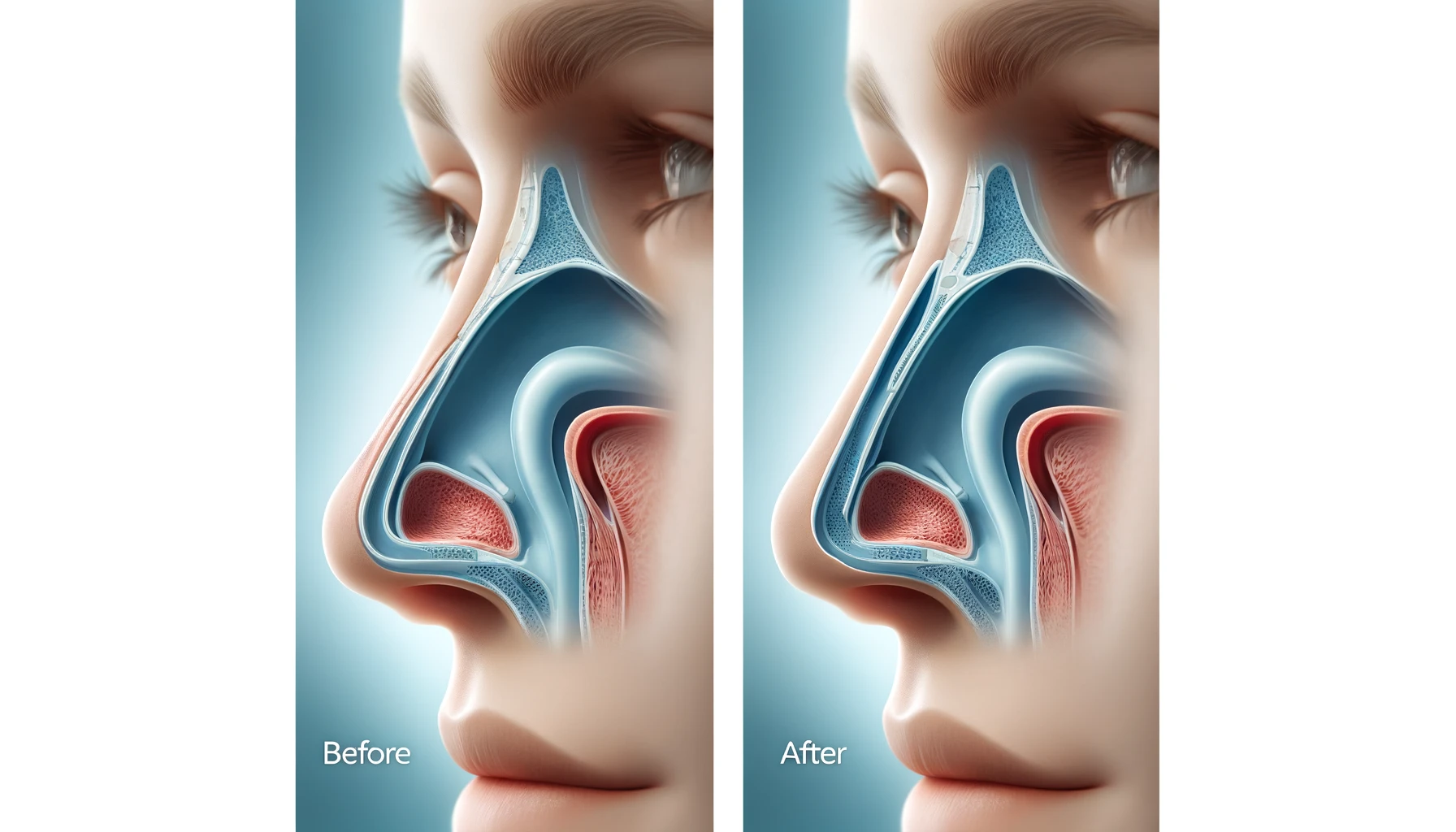
What to Expect from Diagnosis to Recovery
A deviated septum occurs when the nasal septum—the cartilage and bone dividing the two nostrils—is crooked or misaligned. This condition can cause significant breathing difficulties, nasal congestion, frequent sinus infections, and even sleep problems such as snoring or obstructive sleep apnoea. For many individuals, a deviated septum repair is the most effective way to correct these issues and restore normal nasal function.
In this article, we will explore everything you need to know about deviated septum repair, from the diagnosis and treatment options to the recovery process. We will also provide insights from leading ENT consultant Mr Hassan Elhassan, a specialist in nasal surgeries, including septoplasty and complex nasal reconstruction.
What is a Deviated Septum?
The nasal septum is the structure that separates the left and right nasal passages, allowing for proper airflow. In a healthy nose, the septum is relatively straight, ensuring balanced airflow through both nostrils. However, in many people, the septum may be deviated or shifted to one side, causing one nasal passage to be narrower than the other. This misalignment can be due to congenital factors or because of trauma, such as a broken nose.
Symptoms of a deviated septum can include:
- Chronic nasal congestion: One or both sides of the nose may feel constantly blocked.
- Breathing difficulties: Difficulty breathing through the nose, especially on one side.
- Frequent sinus infections: A deviated septum can block sinus drainage, leading to recurrent sinusitis.
- Nosebleeds: A deviated septum can cause dryness or irritation in the nasal passages, leading to frequent nosebleeds.
- Snoring and sleep issues: The restricted airflow caused by a deviated septum can contribute to snoring and, in some cases, sleep apnoea.
Diagnosis of a Deviated Septum
The first step in addressing a deviated septum is a thorough evaluation by an ENT specialist. During a consultation, your doctor will perform a physical examination of the nasal passages using specialised instruments to decide the degree of deviation and whether surgery is needed. In some cases, imaging tests such as CT scans may be used to get a detailed view of the nasal structures.
Once diagnosed, your ENT specialist will discuss the best treatment options for your specific condition. For mild cases of a deviated septum, non-surgical treatments such as nasal sprays, decongestants, or breathing strips may offer temporary relief. However, for more severe deviations, septoplasty—a surgical procedure to straighten the septum—is the most effective solution.
What is Deviated Septum Repair (Septoplasty)?
Septoplasty is the standard surgical procedure for repairing a deviated septum. During this surgery, the surgeon straightens the septum by repositioning or removing portions of bone and cartilage that are causing the blockage. The goal of septoplasty is to improve airflow, relieve nasal congestion, and correct any breathing problems associated with the deviation.
Here’s what you can expect during the deviated septum repair process:
1. Pre-Surgery Consultation
Before undergoing septoplasty, you will have a detailed consultation with your ENT surgeon to discuss your symptoms, medical history, and expectations for the surgery. Your doctor will explain the procedure, risks, and recovery timeline. This is also an opportunity to ask any questions you may have about the surgery.
2. The Septoplasty Procedure
Septoplasty is typically performed under general anaesthesia and can be done on an outpatient basis. The surgery takes about 60 to 90 minutes, depending on the complexity of the deviation. During the procedure, the surgeon will:
- Make a small incision inside the nose to access the septum.
- Reposition or remove the deviated portions of cartilage or bone.
- Close the incision with dissolvable stitches.
- Nasal splints or packing may be placed to support the septum during the first healing phase.
Unlike rhinoplasty, which focuses on reshaping the nose for cosmetic reasons, septoplasty is strictly functional and aims to restore proper nasal airflow.
3. Post-Surgery Recovery
After septoplasty, patients typically experience some swelling, congestion, and mild discomfort, but these symptoms gradually improve over the course of a few weeks. Nasal splints, if used, are usually removed within a week after surgery. Complete healing may take several months, but most patients notice significant improvements in breathing within the first few weeks.
Benefits of Deviated Septum Repair
The main goal of deviated septum repair is to improve breathing and relieve symptoms caused by a blocked or narrowed nasal passage. The key benefits of septoplasty include:
- Improved nasal airflow: Patients often experience dramatic improvement in their ability to breathe through the nose, especially during physical activity or while sleeping.
- Relief from chronic congestion: Septoplasty can cut the persistent nasal blockage and stuffiness associated with a deviated septum.
- Fewer sinus infections: By improving drainage from the sinuses, septoplasty can help reduce the frequency and severity of sinus infections.
- Better sleep quality: Correcting a deviated septum can improve breathing during sleep, reducing snoring and addressing sleep apnoea symptoms.
- Enhanced quality of life: Overall, patients who undergo septoplasty often report a significant improvement in their quality of life, particularly when it comes to breathing, sleep, and daily comfort.
Recovery from Deviated Septum Repair
- Immediate Post-Surgery Care
In the first few days after septoplasty, it’s normal to experience swelling, congestion, and mild pain. Over-the-counter pain relievers, such as ibuprofen or acetaminophen, are usually sufficient to manage discomfort. Your doctor may also prescribe nasal saline sprays to keep the nasal passages moist and promote healing.
- Activity Restrictions
To prevent complications, it’s important to avoid strenuous physical activities, heavy lifting, and bending over for at least 4-6 weeks after surgery. You should also refrain from blowing your nose during the first week post-op to avoid disrupting the healing septum.
- Follow-Up Care
Follow-up appointments with your ENT specialist are essential to check the healing process. During these visits, your doctor will check the position of the septum, remove any splints or packing, and ensure that you are healing properly.
Most patients can return to work and normal activities within 1-2 weeks, although it may take up to 3 months for the nasal tissues to fully heal. Full breathing improvement is usually noticeable within a few weeks after surgery.
Is Deviated Septum Repair Right for You?
If you struggle with chronic nasal congestion, breathing difficulties, or frequent sinus infections due to a deviated septum, septoplasty may be the solution to improve your quality of life. Consulting with an experienced ENT specialist like Mr Hassan Elhassan can help you decide whether deviated septum repair is the right choice for you. With the right care, you can achieve long-lasting relief from nasal blockages and enjoy improved breathing and overall comfort.
Mr Hassan Elhassan
Published by septalperforation.co.uk

Mr Hassan Elhassan, a leading ENT consultant with over 19 years of experience, is an expert in deviated septum repair and endoscopic sinus surgery. Having trained at some of the world’s top sinus surgery centres, Mr Elhassan is known for his advanced techniques and precision in nasal surgeries.
He has performed many successful septoplasty procedures, providing patients with lasting relief from nasal congestion, breathing difficulties, and frequent sinus infections. His surgical ability is complemented by a patient-centred approach, ensuring that everyone receives personalised care based on their unique needs and goals. Mr Elhassan is also highly skilled in revision surgeries, helping patients who have had unsuccessful earlier procedures.
With his experience as Deputy Clinical Director of ENT in London and his work at Homerton University Hospital and London Bridge Hospital, Mr Elhassan is trusted by both patients and colleagues for his exceptional outcomes in nasal surgery.
